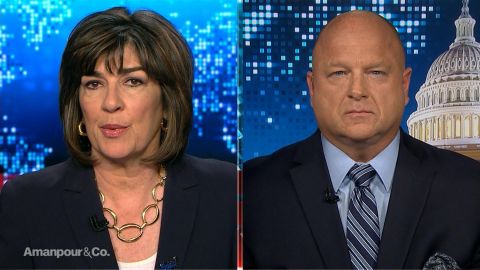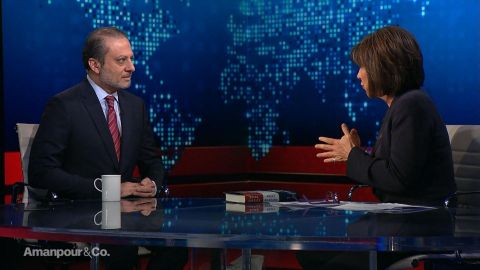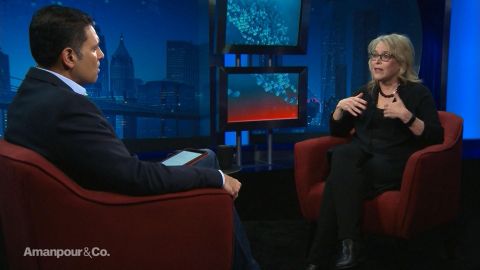Read Transcript EXPAND
CHRISTIANE AMANPOUR: But next tonight, reflections on mental health. U.S. suicide rates are the highest in 50 years. And they show a steady increase since the turn of the 2000s. Last month, three prominent suicides received national attention. Two teenagers who survived last year’s Parkland school shootings and the father of a child who was killed in the Sandy Hook School massacre in 2012. They all took their own lives and all within days of each other. Our next guest, Rachel Yehuda is the director of the Traumatic Stress Studies at New York’s Mount Sinai School of Medicine. And she calls America’s suicide crisis an epidemic telling our Hari Sreenivasan that much more mental health resources are needed.
HARI SREENIVASAN: So just so we have kind of a baseline understanding, what is PTSD?
RACHEL YEHUDA, VICE CHAIR, MOUNT SINAI DEPARTMENT OF PSYCHIATRY: PTSD stands for post-traumatic stress disorder. It’s a condition that occur — that can occur following traumatic exposure. And it’s characterized by a lot of different kinds of symptoms. There are certainly reminders of the trauma that can prove very distressing. People have memories when they don’t want to have them. They can have flashbacks. They can have nightmares. They go to great lengths to avoid any reminder of the traumatic experience. They change the way that they view the world. They can become depressed and start to get all sorts of ideas about that the world isn’t safe or their whole belief system is shattered. And then there are some real physiological symptoms like not being able to sleep or concentrate or feeling hyper-vigilant or irritable and angry.
SREENIVASAN: What’s the connection between surviving trauma and suicide?
YEHUDA: The connection is that many people who survive trauma, especially the ones who developed post-traumatic stress disorder, are at increased risk for suicidality. And so there is a link that is becoming much more appreciated that exposure to traumatic events and especially having PTSD following those events will increase the likelihood that the trauma survivor will make a suicide attempt or may even have a successful suicide.
SREENIVASAN: Do we have kind of numbers yet on that?
YEHUDA: Well, we know that the rate of suicidality is increased by about 28 percent if you have PTSD. We know that depending on the type of trauma that someone has been exposed to, there’s an increased risk of suicide attempts. So for example, somebody has been exposed to rape or interpersonal violence, there’s like a 22 percent and 23 percent chance that they will make an attempt at some time during their lives. Among adolescents who are exposed to trauma, the rate is even higher. And among adolescents who are exposed to school shootings, the prevalence of PTSD is very high in the 70s.
SREENIVASAN: Seventy percent of the kids that are exposed to the trauma in a school shooting?
YEHUDA: Yes, according to some studies. So that’s a really high percent.
SREENIVASAN: Now, how does that manifest itself? Do these kids come out as depressed? Do they come out as — with suicidal ideation right away? Is it onset slowly? Are there warning signs that we can pick up on?
YEHUDA: Sometimes, suicidal ideation is something that happens over time as people are attempting to cope with the symptoms of a trauma and are not being very successful at it. The idea of suicide comes up as a possible way to deal with one’s problems. So I don’t think that is something that happens right away. I think that it takes time. Most people who are exposed to a trauma are told, and it’s correct to be told this, that with the passage of time, you’ll feel better. And that’s generally true with the passage of time, a lot of the symptoms of PTSD do get better. Certainly, if there’s mental health treatment. But even sometimes if there’s really good social support, that can reduce some of the edge off of PTSD symptoms. But in a case where somebody is not getting better, the symptoms of PTSD themselves can really work in concert to increase this idea that things might be better if my life was over. And so this can happen when you feel like the PTSD is causing you to be very isolated from other people and you are left all alone to cope and the burden is very difficult for you. It can occur when you realize that you’re a burden to your family because you’re not alone and that a lot of people are trying very, very hard to help you. But nonetheless, your pain is very great, and so this idea that you might be able to release your family of the burden of having to care for you again. Remember, PTSD changes the way you think. So it’s not necessarily the correct idea —
SREENIVASAN: You aren’t thinking clearly.
YEHUDA: They’re not thinking clearly. But in some internal logic, there is this idea. Another very common thing is that people feel very angry inside. You hear this from a lot of people, particularly combat veterans and rape victims. They are angry. And they feel that there’s a monster inside of them that somehow needs to be shut down and maybe suicide is the way because if you don’t shut down this angry monster within, maybe the irritability will come out and hurt people that you love. So there are all these reasons that people might have. Now, of course, if you talk to someone externally, they’ll be able to tell you that the reasons aren’t so logical.
SREENIVASAN: Are there different groups of people that are more likely to experience not just trauma but suicidal ideation, for example, police officers might be an at-risk community, veterans might be.
YEHUDA: Police officers are at very high risk for suicide. We know that this is the case. And the questions we have to ask about that is whether there are appropriate ways that people who are in crisis with occupational hazards like being a policeman or being an EMT or being a firefighter, whether there is an adequate amount of resources that can deal with problems that can be detected earlier on or whether the cultures promote a suppression of talking about those problems. And it’s just an obligation that we have to make sure that there are places that people can go when they are feeling in trouble so that it doesn’t compound so that they feel that suicide is the only way out.
SREENIVASAN: You are also pointing out very chemical and physiological changes that are happening in the brain. It’s maybe 20, 30 years ago we were just describing it, oh, it is somebody is feeling this way. But at this point, science has figured out how our brain actually changes with this?
YEHUDA: Science has figured out how our brain changes in response to trauma exposure and also when people have PTSD. And these changes are real. And they should be very validating to people that have the disorder. But what’s more important is that if you can understand what is going wrong, you can maybe try to figure out how to make it right. And so scientists have really been working very hard to figure out how to reverse the symptoms. It’s really very important to let people know that treatment can make it better. Finding treatment might be very difficult because I think there’s a real opportunity here to talk about the fact that there is a crisis in mental health access. But if we could deal with that crisis, if we could make mental health more available to the people that need it, then we might be able to do something about what, to me, seems like a real epidemic of suicide.
SREENIVASAN: The CDC says that basically, suicides are up since the turn of the century. Why is that?
YEHUDA: Yes, they are up about 30 percent since the turn of the century. And they’ve been gradually increasing a little bit every year. Nobody knows why that is. I think that it’s alarming. But, look, there are a lot of contributors. In 2016, for example, there were about 44,000 suicides, completed suicides in this country. About half of them, more than half of them, 22,000-plus use firearms.
SREENIVASAN: So the largest number of (INAUDIBLE) in America is from firearms and I think suicides, right?
YEHUDA: Yes. And so we have to really think about whether it’s easier to die by suicide. We have to think about other means that people use. We have to think about whether we’re making help available to people who are just starting to talk a little bit more about death without expressing overt suicidal intentions but just statements like, I’d be better off dead or I bet death would be painless.
SREENIVASAN: So if someone says that to you, what should be the alarm bell? What should be the response?
YEHUDA: the response should be to talk more about that. And not to directly challenge it by saying, oh, no, that’s a ridiculous idea, but by inquiring about what is going on to make you say that. Are you doing OK? That statement suggests that something is wrong, that you’re not feeling very well, that you are depressed. Is that something you would like to discuss further with me? Do you need support? I’m here to listen. I can help you hold whatever burden you’re carrying. Do you want me to help you get mental health treatment? Do you want me to help support you in some way possible? The idea is to rally around the person who is expressing those thoughts and to take them seriously.
SREENIVASAN: Does that make a difference?
YEHUDA: Yes. I believe that makes a huge difference. But I think that people are very afraid to talk about suicide because they think that just bringing it up might give somebody the idea.
SREENIVASAN: Right.
YEHUDA: Maybe somebody says I’m sad and you say, well, are you feeling like you might want to kill yourself? And then they weren’t thinking about it and you just put the idea in their head but that’s not how it works. What happens is that people might first contemplate suicidal ideation, low- grade things without having a plan or without thinking about how they might do it. But they might start out thinking pain is very bad, I’d be better off dead. If I were dead, I wouldn’t feel this pain. And then they would graduate to another level of how they might do it. Should I begin to stockpile pills, for example, or something like that? So if you begin to have a conversation with somebody at an early phase, then you can kind of work with that and see whether these symptoms escalate and then really help the person get mental health treatment, community support, social support. When people feel that they’re not alone, this can be enormously helpful. When people feel that you truly care about them and that they’re not a burden to you and that you will help them, this makes an enormous difference.
SREENIVASAN: How much of this has to do with our ability to be resilient? Because there are going to be people that say, you know what, lots of people experience trauma. Some of them get through it. Some of them, it makes them stronger. And then other people, they sort of take this other path., right. So we have no uniform response to how we all deal with the challenges that we face, right?
YEHUDA: But it’s not binary. And that’s really important. It’s — every person PTSD has some spark of resilience in them. And what we want to be able to do is find that spark and fan that flame so that the resilient side sort of out shadows, the light gets bigger than the dark. And I think that it’s a constant struggle for people to go to their light side and not go to their dark side. But the fact is that when you have been through something as troubling as a school shooting or some interpersonal violence or rape or combat or anything like that, you are struggling for that light. And that — it’s not binary of some people get it, some people don’t. Even people that may not meet full criteria for PTSD can be very affected by the traumatic events that have occurred to them. So this idea of resilience is a life-long process. It’s a struggle that we have to wellness, to recovery. Ultimately, it involves being able to talk about what happened, being able to go down to the deepest fears about you as a person. A lot of people have survival guilt, guilt about how they could let themselves be victimized. They blame themselves. They feel helpless. They feel terrible about themselves. And these are deep, dark secrets that they hold very tightly inside of them. And they need to be released. They need to come out and then eventually people can work towards the next step which is finding meaning and purpose in their trauma and in their suffering. And then they can cross over to a side where maybe they can find more resilience than pain.
SREENIVASAN: Have we collectively made it more acceptable? Because I think different cultures treat it differently. Some places place a lot of shame on it, say that’s just not an option, that should never be a way out, right. But somewhere in the United States right now, when we hear of someone taking their own life, we say, well — it’s not that we’re collectively outraged and say that’s unacceptable.
YEHUDA: We’re not as outraged as we used to be. And I think that suicide is less stigmatized. I think that there’s a positive aspect towards that, too. I think understanding that it’s part of either a mental illness or a very deep existential struggle, I think is more humanizing. But we want to stop short of glamorizing it, too. So we want to stop short of letting people know that it’s an acceptable statement to make if it’s satisfied with what is going on in the world. It’s understandable but it’s tragic. And I think this idea of the pain that people leave behind in the aftermath of these events is something that the families struggle with for a lifetime. It haunts them for a lifetime.
SREENIVASAN: In the wake of the suicides by the two children who survived Parkland and the father who lost a child who was murdered at Sandy Hook, are there longer-term implications for these communities or even generationally?
YEHUDA: Yes. I think that these events do reverberate. But I think that what the Parkland children tried very hard to do was use the adversity to try to effect change. I think change is hard to effect but that’s the right idea. And that is something that we should also take as our mandate following these kinds of tragedies.
SREENIVASAN: Thanks so much for joining us.
YEHUDA: OK.
About This Episode EXPAND
Christiane Amanpour speaks with David Urban about President Trump’s 2020 campaign; and Preet Bharara about his time as the U.S. Attorney for the Southern District of New York, before he was fired by President Trump. Hari Sreenivasan speaks with Dr. Rachel Yehuda about the effects of PTSD.
LEARN MORE


